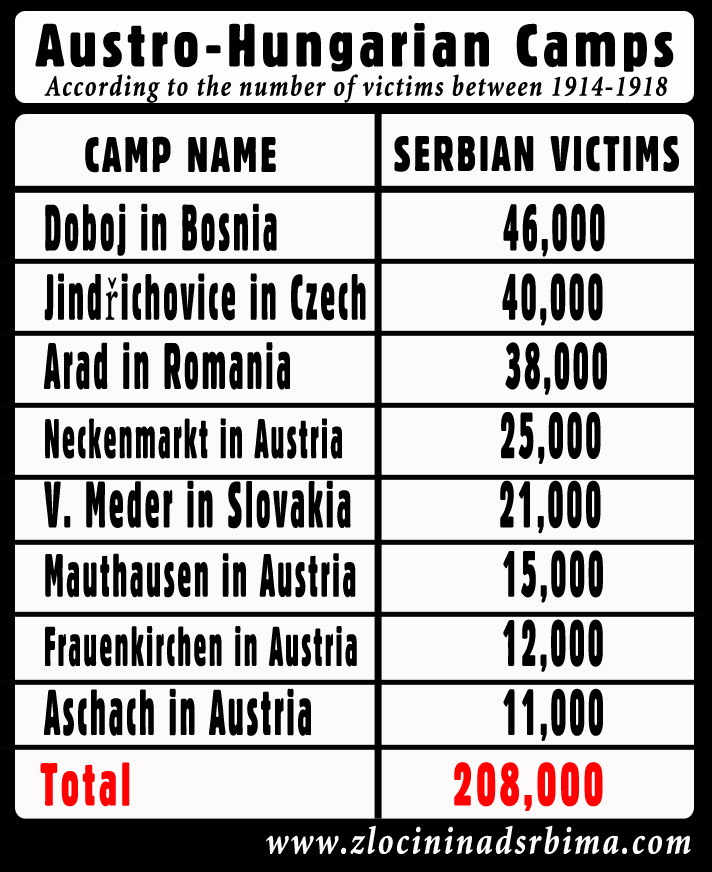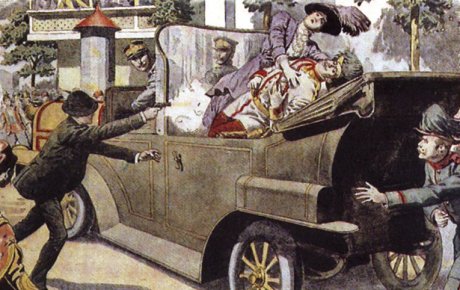|
|
Period:
First World War
Region:
Germany
German camp Kuhberg in Ulm
 The Kuhberg concentration camp, not far from the town of Ulm, used to be a torture sight for Serbs, Russians, and Slavic peoples, in general. It was constructed by the German authorities during World War I. This camp existed for almost five years, more specifically from 1914 to 1919. The Kuhberg concentration camp, not far from the town of Ulm, used to be a torture sight for Serbs, Russians, and Slavic peoples, in general. It was constructed by the German authorities during World War I. This camp existed for almost five years, more specifically from 1914 to 1919.
Thousands of Serbs were held here, civilians and soldiers, and 146 of those who were buried in the camp’s graveyard are known by their first and last names. At the location of the former prison, the surviving Serbian soldiers invested their efforts and donations to erect a monument for their fallen comrades and friends.
Camp inmates brought from Serbia were mostly from the following regions: Podrinje (Pordinye), Pomoravlje (Pomoravlye ), Posavina, Kolubara. While inmates brought from the Kingdom of Serbia were from Timočka, Moravska, and Drinska divisions.
The government of the Kingdom of Yugoslavia paid a bit more attention to monuments and death-zones from the Great War around Europe (Czech Republic, Slovakia, the Netherlands, Romania, Greece, Germany, Austria), while Yugoslav communists did not do anything regarding the preservation of monuments or even allowed memorials, but they were forgotten instead. It was estimated that in Germany, during World War I, at least 15,000 Serbs were imprisoned.
Today the monument in Ulm was renovated (more or less) thanks to the Lukić family and the delegations usually place flowers on the 11th of November, when the victory day of World War I is marked.
|
FIRST WORLD WAR 1914-1918 |
|
Battles of: Cer, Drina, Kolubara, Leget, Cemerno, Mojkovac, Kajmakcalan, Gornicevo, Dobro Polje
Camps: Mauthausen, Arad, Jindrihovice, Broumov, Boldogasonj, Nadjimer, Nezider, Aschah, Doboj, Sliven
Crimes: Macva, Surdulica, Great Retreat, Sabac
|
BACKGROUND
At the beginning of 1904, the Kingdom of Serbia signed a trade agreement with the USA, France and Russia... and began exporting its products to the overseas countries through the port of Thessaloniki.
This led to a great economic upswing of the Kingdom of Serbia, which annoyed the Vienna Court, which viewed Serbia as a great rival since Serbia had the highest economic growth rate in Europe at the time, and at the same time a large number of Serbs lived in the occupied territories of the Habsburg Monarchy.

Map of south-eastern Europe in November 1913.
The army of the Kingdom of Serbia liberated its enslaved territories (Raska, Kosovo and Metohija and Old Serbia) from the Turks in the First Balkan War, by achieving major victories in the fall of 1912 at the command of Duke Petar Bojovic at Kumanovo, Prilep and Bitola, and as such completely expelled the Ottomans from the Balkans.
And a year later in the summer of 1913 the army of the Kingdom of Serbia protected Vardar Macedonia from the Bulgarians in the Second Balkan War. The Serbian national revolution was thus continued, at the beginning of the 19th century by Karadjordje Petrovic and Milos Obrenovic.
In the summer of 1914, the Austro-Hungarian Monarchy used the Sarajevo assassination, that is, the assassination of Austrian Crown Prince Franz Ferdinand by members of Young Bosnia (Gavrilo Princip, Bogdan Zerajic, etc.) as an excuse to invade the Kingdom of Serbia, thus starting First World War.

Gavrilo Princip and his comrades in Sarajevo
A dispatch was sent from Vienna, which no sovereign state could accept. Thus, in late July 1914, Austria-Hungary declared war on Serbia. Montenegrin King Nikola I Petrovic and Russian Emperor Nikolai II Romanov immediately sent messages saying that they would help the Serbs. Likewise, German Emperor William II made a military alliance with the Vienna Palace.
ESTABLISHMENT
Shortly after the start of World War I, German authorities began constructing concentration camps similar to those in Austria, in which they housed inmates (civilians and soldiers) from the enemies they fought.
One of these camps was Kuhberg (SRB. “Kravlje Brdo”), more specifically a fort, near the town of Ulm, which lies on the Danube river between Stuttgart and Munich in southern Germany, in the municipality Baden-Württemberg. The camp itself was established under the authority of the German government.
Through this camp, at least 2,000 Serbs passed and a few hundred Russians who were also brought in by boats over the Danube.
In camp Kuhberg, there were soldiers from the Kingdom of Serbia, who were from Timočka, Moravska and Drinska divisions, who were captured in battles such as the Battle of Cer, Kolubara, Suvobor, Leget, Mačkov Kamen, Gučevo…
Similarly, Serbian civilians were brought in from northern and western parts of the Serbian kingdom: Podrinje, Posavina, Pomoravlje (Pomoravlje), Kolubara and Ljig areas. Women, children, and the elderly were also brought in.
CAMP CONDITIONS
As in all other Germanic concentration camps, so was here in the Ulm detention camp where people received inhumane treatment, where thirst and hunger ruled, while cold and diseases fed upon the inmates.
The prisoners had no rights whatsoever, and medical help did not even exist. Typhus sent many to their graves.
Similarly, many Serbian inmates died of exhaustion due to forced labor, which was mandatory for all inmates.
Any attempts of escape were punished by death, usually in front of the firing squad.
CLOSURE
The Camp Kuhberg stopped its operations only after the treaty of Versailles in France in late June 1919, when Germany, Austria, and Hungary as the defeated factions in the “Great War” had to quickly deconstruct all concentration camps on their territories.
Hence, the surviving Serbs and Russians on the 1st of July 1919 began returning to their homes. This path was not easy as they walked more than they travelled by boats or train wagons. Many of them died on the way to their homes and even upon arrival.
MONUMENT CONSTRUCTION
Sadly, the monument which we have today was not constructed by the Kingdom of Serbia, neither Kingdom of Yugoslavia.
Those were surviving inmates (three sergeants, one corporal, and two soldiers ) from Ulm camp who, in the 1920s, raised a monument of their own accord and effort for their fallen comrades and friends, as well as for the Serbian youth which remained there forever, on this graveyard of soldiers. A little further from the monument is the large monument erected for the Russians who suffered the same fate.
The Serbian monument is 4 m long and 3m high, it depicts a Serbian soldier who lays on a rock with a uniform and “Šajkaca” (National cap of Serbia), and under the rock lay the bones of 146 soldiers.
On the monument, work of the sculptor Carlo Varley, the following words are engraved, written in Serbian and German languages with both Cyrillic and Latin alphabets:
- “Here in a foreign land, in a foreign world, rest in everlasting dreams Serbian prisoners of war from the war of 1914-1919, who gave up their lives for their homeland after long fighting and many sufferings. This monument was raised by their friends, brothers by blood and faith, Serbian prisoners of war in Ulm. Hey, traveler, who passes by the unknown grave, wait and get to know those who died in glory”.
YEARS LATER
Authorities of the Yugoslavian kingdom until 1941 didn’t invest in this monument and have never visited these death-sights of Serbs from the Great war. One Serbian woman from Herzegovina, Desanka Rajhle (born in Mostar), who is married to a German accidentally discovered this monument and immediately contacted the Serbian Orthodox Church in the town of Ulm.
Hence, services have been held for Serbian martyrs in Kuhberg for more than four decades.
Priests of the Serbian Orthodox Church Slobodan, Miljević, and Radmilo Marinko have collected information about how many soldiers died, as well as their names. This information is kept in the church of Ulm.
Until 2010, the monument had no maintenance. As it was dirty and covered with overgrown moss, outstanding social workers from Stuttgart, Nada and Relja Lukić in an agreement with the representatives of the Serbian Orthodox Church and Serbian consulate in Stuttgart, have cleaned the soldiers’ grave. As they had insufficient funds for the renovation, the Lukić family managed to secure necessary licenses over their firm and reconstructed the monument.
PUBLICATIONS
Niether a documentary film or a book was published about the Kuhberg camp.
Tags:
Please, vote for this article:
Visited: 2804 point
Number of votes: 0
|